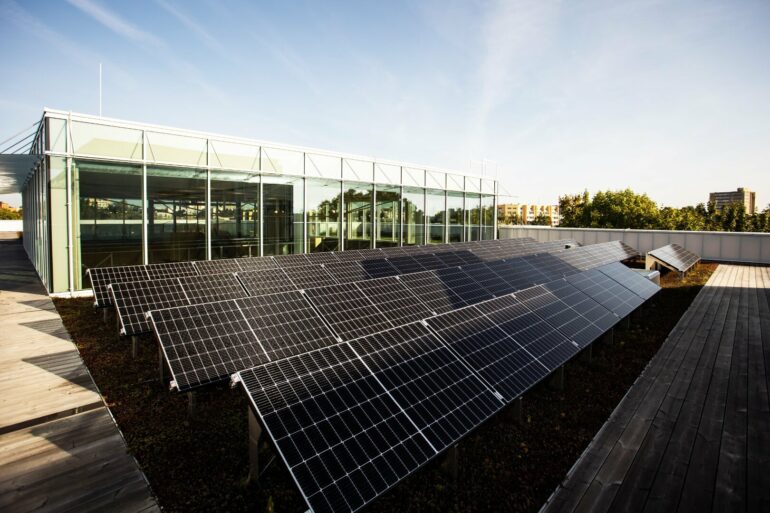A team of chemists from Kaunas University of Technology (KTU), Lithuania, developed a new material for perovskite solar cells. After polymerization, it can be used as a hole transporting layer in both regular and inverted architecture solar cells; in both cases, the solar elements constructed have better power conversion efficiencies and operational stability.
Perovskite solar cells (PSCs) have received significant interest from the photovoltaic community due to their skyrocketing power conversion. Moreover, PSCs may be scaled up using a low-cost production process from widely available abundant raw materials. These aspects show promise for PSCs as a future mainstream photovoltaic technology.
However, the long-term stability of perovskite solar devices under practical working conditions still requires further improvement to satisfy market demands.
A novel 9,9′-spirobifluorene derivative bearing thermally cross-linkable vinyl groups, synthesized by the team of chemists at KTU, Lithuania, could help solving some of the above-mentioned challenges. After thermal cross-linking, a smooth and solvent-resistant three-dimensional (3D) polymeric network was formed, which was used as a hole-transporting material to construct perovskite solar cells.
“The copolymerization takes place at a relatively low temperature (103°C), which makes the technology safe for use in the casting of a layer on perovskite, which is not resistant to temperatures above 140°C. Another very important aspect is that the polymerization process is incredibly fast, apparently due to the specific spatial configuration of the monomer,” says Šarunė Daškevičiūtė-Gegužienė, one of the authors of the invention, a Ph.D. student at KTU Faculty of Chemical Technology.
The resulting devices exhibited better energy conversion efficiency and, most importantly, stability than conventional hole transporting materials (PTAA or Spiro-OMeTAD).
Commercialization possibilities, patent pending
PSCs, layered, new-generation solar cells can have two architectonic structures—regular (n-i-p) and inverted (p-i-n). In the latter, the hole-transporting materials are deposited under the perovskite absorber layer. The monomer, synthesized at KTU laboratories easily produces solvent-resistant three-dimensional (3D) polymers that can be used in both types of perovskite solar cells.
“Polymer synthesis is carried out by heating the monomer layers for as little as 15 min, yielding spatially structured insoluble polymer matrices,” explains Professor Vytautas Getautis, the Lead Researcher at the Synthesis of Organic Semiconductors research group at KTU.
To date, the best performances of conventional structure (n-i-p) perovskite solar cells have been achieved with the well-studied p-type semiconductor Spiro-OMeTAD. However, the latter has not found application in inverted structure (p-i-n) devices due to its solubility, as the polar solvents used in the molding of the perovskite layer dissolve the hole-transporting layer below.
The 9,9′-spirobifluorene derivative synthesized at KTU laboratories yields a cross-linked organic solvent-resistant polymer layer. Meanwhile, a copolymer of the 9,9′-spirobifluorene derivative with a dithiol (e.g. 4,4′-thiobisbenzenethiol), formed on the perovskite layer in the construction of (n-i-p)-structured devices, protects it from external unwanted influences such as humidity.
According to researchers, the novel synthesized material has high commercialization potential. Therefore, the patent application was filed at the EU, U.S., and Japanese patent offices.
Cooperation between Lithuanian and Japanese scientists
The researchers emphasize that the results achieved are the product of successful collaboration between Lithuanian and Japanese scientists.
“For several years now, our research group has been collaborating with that of Prof. Atsushi Wakamiya at Kyoto University, which is well-known among perovskite solar cell researchers not only in Japan but also worldwide. It was they who designed and characterized perovskite solar cells using our synthesized p-type organic semiconductors,” says Prof. Getautis.
The electrical properties of these semiconductors have been investigated by KTU chemists’ long-time partner, Prof. Vygintas Jankauskas from Vilnius University.
KTU research group, under the lead of Prof. Getautis, is responsible for numerous innovations in the solar technology field. Among them are synthesized compounds, which self-assemble into a molecule-thin layer that acts as a hole-transporting material, which has been used to construct record-breaking silicone-perovskite tandem solar cells.
According to Prof. Getautis, of all renewables, solar energy has the largest potential and is the least exploited. However, thanks to the new research, this field is developing exponentially. It is estimated that by 2050, around half of the electricity used on Earth will be produced from solar energy.
“Solar energy is entirely green—it is pollution-free, and the installed solar farms don’t require much maintenance. Keeping in mind current events, and the energy crisis, more and more people are interested in installing solar power plants in their homes or owing a share of a solar farm. It is a future of energy,” says Prof. Getautis.
The work is published in the journal ACS Applied Materials & Interfaces.
More information:
Sarune Daskeviciute-Geguziene et al, In Situ Thermal Cross-Linking of 9,9′-Spirobifluorene-Based Hole-Transporting Layer for Perovskite Solar Cells, ACS Applied Materials & Interfaces (2023). DOI: 10.1021/acsami.3c13950
Provided by
Kaunas University of Technology
Citation:
Novel material for perovskite solar cells can improve their stability and efficiency (2024, March 19)



